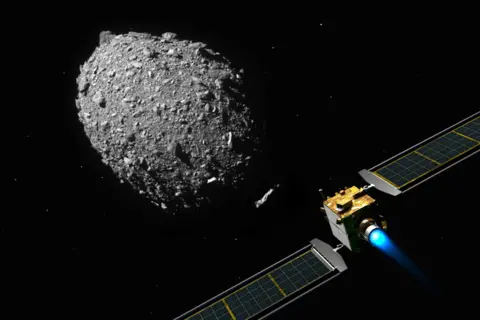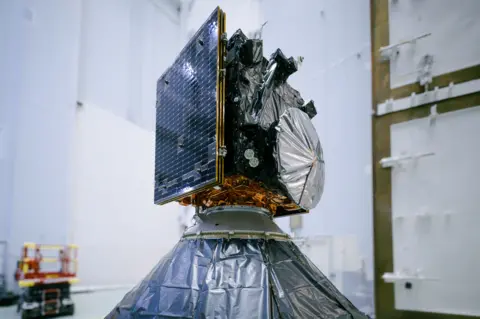Spacecraft launches towards asteroid knocked off course by Nasa
A spacecraft is on its way to visit an asteroid that US space agency Nasa knocked off course in 2022.
The Hera craft launched from Cape Canaveral in Florida at 10:52 local time (15:52BST) on Monday.
It is part of an international mission to see if we can stop dangerous asteroids hitting Earth.
The project will look at what happened to a space rock called Dimorphos when Nasa intentionally collided with it.
If all goes to plan, Hera will reach Dimorphos, around seven million miles away, in December 2026.
The Hera mission, which is run by the European Space Agency, is a follow-on from Nasa’s Double Asteroid Redirection Test (DART) project.
Dimorphos is a small moon 160m-wide that orbits an asteroid close to Earth called Didymos in something called a binary asteroid system.
In 2022 Nasa said it successfully changed Dimorphos’s course by crashing a probe into it. It altered the rock’s path by a few metres, according to Nasa’s scientists.
The asteroid was not on course to hit Earth, but it was a test to see whether space agencies could do it when there is genuine risk.
When it arrives in two years, the Hera craft will look at the size and depth of the impact crater created on Dimorphos.
 NASA
NASATwo cube-shaped probes will also study the make-up of the asteroid and its mass.
“We need to understand what are the physical properties of these asteroids? What are they made of? Are they blocks of rock? Are they made of sand inside?” says Naomi Murdoch, a scientist involved with the European Space Agency mission.
That should help scientists understand the best way to attempt to intercept other asteroids, which can be many different sizes and shapes, in the future.
Scientists do not believe that we are currently at risk of a dinosaur-style extinction caused by an asteroid hitting Earth. An asteroid of that size could be easily spotted in space.
The size of asteroid that DART and Hera are targeting are about 100-200m wide and are very difficult to see from our planet.
From time to time they hit Earth. On 2013 a house-sized asteroid exploded in the sky above the town of Chelyabinsk in Russia. The shock wave blew out windows for over 200 square miles and damaged buildings. Over 1,600 people were injured in the blast.
Scientists hope to one day be able to identify asteroids like this and knock them off course.
“It's not to avoid an extinction of the human race. It's to create a system to minimize the damage as much as we can. The dinosaurs didn't have a space program, but we do,” says Prof Murdoch.
But scientists warn that even though Nasa has proved it is possible to alter one asteroid’s course, it does not mean it can easily be done on all space rocks.
Intercepting an asteroid before it hits Earth also relies on being able to spot the incoming hazard in the first place.
 SpaceX
SpaceX